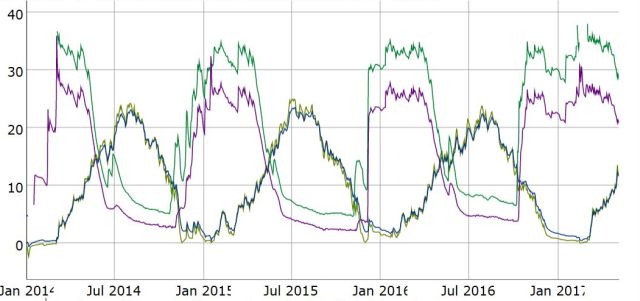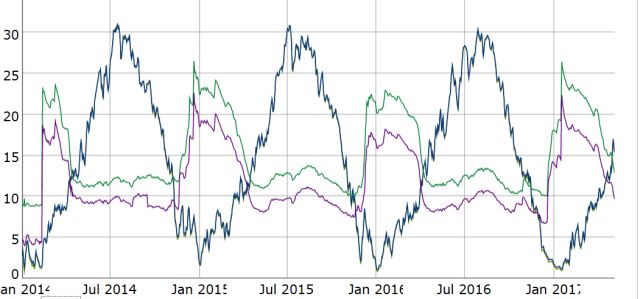Wednesday, May 10, 2017
Another casualty of winter /// EDIT: Well, maybe.
The tunnel collapse at Hanford is probably another symptom of this winter's unusual pattern of moisture and freezing.
The result in Spokane is a scattering of water pipe breaks and flooded basements and ruined streets. October was super-wet, filling the soil with water; then the winter was unusually (but not super) cold, freezing the heavy load of water. March added another load of water just as the soil was starting to thaw. Newer streets and newer pipes were OK, but older pavement and weak pipes broke.
Using the USGS soil moisture website again...
Here's a measuring station near Spokane:
 Dark green is shallow moisture, purple is deep moisture. Light green is shallow temp, blue is deep temp. In this case the temperature seems to be the abnormal variable this year. Got cold and stayed cold while the moisture piled up.
= = = = =
Now here's a site near Lind, which is closer to Hanford but not close enough to be sure:
Dark green is shallow moisture, purple is deep moisture. Light green is shallow temp, blue is deep temp. In this case the temperature seems to be the abnormal variable this year. Got cold and stayed cold while the moisture piled up.
= = = = =
Now here's a site near Lind, which is closer to Hanford but not close enough to be sure:
 It's consistently different from the Spokane reading; looks like the deep and shallow are more 'decoupled' than the Spokane, and the deep is low-passed. I don't know if that's an artifact of measurement or a product of different soil. This winter's anomaly shows up sharply in the deep moisture (purple) line. Loaded up MUCH more than previous years, stayed around longer.
Oops. The Lind station seems to have halted in 2016, so those lines don't mean anything. Here's a chart from John Day in Oregon, south of Hanford:
It's consistently different from the Spokane reading; looks like the deep and shallow are more 'decoupled' than the Spokane, and the deep is low-passed. I don't know if that's an artifact of measurement or a product of different soil. This winter's anomaly shows up sharply in the deep moisture (purple) line. Loaded up MUCH more than previous years, stayed around longer.
Oops. The Lind station seems to have halted in 2016, so those lines don't mean anything. Here's a chart from John Day in Oregon, south of Hanford:
 This year doesn't look especially unusual. More shallow moisture than usual, but it decreased fairly fast. So the cause still seems intuitively likely but I don't have enough data to support the idea.
This year doesn't look especially unusual. More shallow moisture than usual, but it decreased fairly fast. So the cause still seems intuitively likely but I don't have enough data to support the idea.
 Dark green is shallow moisture, purple is deep moisture. Light green is shallow temp, blue is deep temp. In this case the temperature seems to be the abnormal variable this year. Got cold and stayed cold while the moisture piled up.
= = = = =
Now here's a site near Lind, which is closer to Hanford but not close enough to be sure:
Dark green is shallow moisture, purple is deep moisture. Light green is shallow temp, blue is deep temp. In this case the temperature seems to be the abnormal variable this year. Got cold and stayed cold while the moisture piled up.
= = = = =
Now here's a site near Lind, which is closer to Hanford but not close enough to be sure:
 It's consistently different from the Spokane reading; looks like the deep and shallow are more 'decoupled' than the Spokane, and the deep is low-passed. I don't know if that's an artifact of measurement or a product of different soil. This winter's anomaly shows up sharply in the deep moisture (purple) line. Loaded up MUCH more than previous years, stayed around longer.
Oops. The Lind station seems to have halted in 2016, so those lines don't mean anything. Here's a chart from John Day in Oregon, south of Hanford:
It's consistently different from the Spokane reading; looks like the deep and shallow are more 'decoupled' than the Spokane, and the deep is low-passed. I don't know if that's an artifact of measurement or a product of different soil. This winter's anomaly shows up sharply in the deep moisture (purple) line. Loaded up MUCH more than previous years, stayed around longer.
Oops. The Lind station seems to have halted in 2016, so those lines don't mean anything. Here's a chart from John Day in Oregon, south of Hanford:
 This year doesn't look especially unusual. More shallow moisture than usual, but it decreased fairly fast. So the cause still seems intuitively likely but I don't have enough data to support the idea.
This year doesn't look especially unusual. More shallow moisture than usual, but it decreased fairly fast. So the cause still seems intuitively likely but I don't have enough data to support the idea.
Labels: Heimatkunde, Metrology
